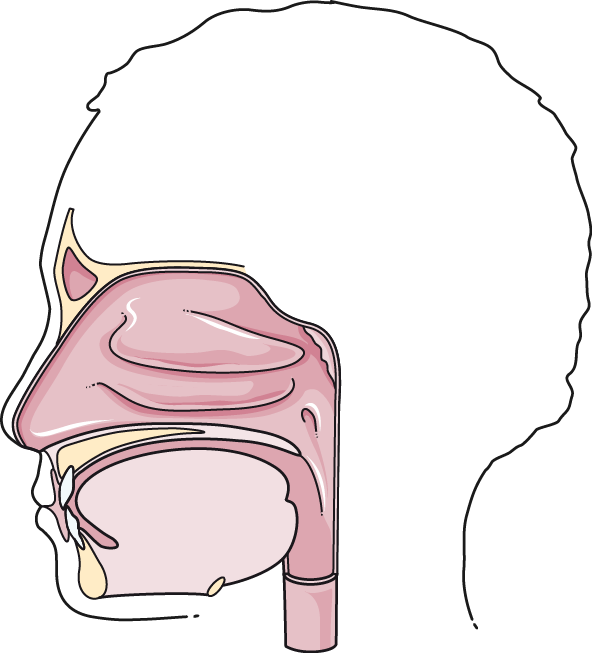Areas of Clinical Focus – Video
Cardiovascular Emergencies – Video
Airway Obstruction – Text
I. Etiology of Airway Obstruction
1. Upper Airway Obstruction
The upper airway is susceptible to various obstructions, each having unique origins and clinical implications.

a. Relaxation of the tongue against hypopharynx: This is the primary cause of obstruction in unconscious patients. The muscle relaxation leads to the tongue falling back and obstructing the airway.
b. Foreign body aspiration:
Aspiration of food: A common cause of obstruction in conscious patients, often resulting from improper chewing or swallowing.
Vomitus: An obstruction can occur from the aspiration of vomit.
Dentures: Ill-fitting or dislodged dentures can obstruct the airway.
c. Tumor: Growth of malignant or benign tumors can impede airflow.
d. Hematoma: Accumulation of blood outside the blood vessels may compress the airway.
e. Laryngeal spasm and edema: Involuntary contractions or swelling of the larynx may lead to acute obstruction.
f. Vocal cord paralysis: This can be a result of nerve damage or underlying medical conditions, leading to an inability to move the vocal cords.
g. Infection: Infections such as epiglottitis can lead to inflammation and blockage.
h. Trauma: Physical injuries such as a fractured trachea can severely obstruct the airway.
i. Obstructive sleep apnea (OSA): OSA can be caused by various factors, including:
Increased neck circumference
Tonsillar hypertrophy
High arched palate
Small or receding jaw
Obesity
Smoking
Alcohol use: Alcohol consumption may lead to relaxation of the airway muscles, exacerbating OSA.
2. Lower Airway Obstruction
Lower airway obstructions include the following:
a. Foreign bodies: Inhalation of small objects or particles can cause an obstruction.
b. Secretions: Accumulated mucus or secretions can obstruct the bronchi.
c. Hemorrhage: Bleeding into the airways may cause a blockage.
d. Pneumonia: Inflammation and infection of the lungs can lead to obstructed airflow.
e. Space-occupying lesions and tumors: These can compress or obstruct the bronchi, leading to restricted airflow.
f. Bronchospasm: Constriction of the bronchi and bronchioles may occur in asthma or chronic bronchitis, leading to obstruction.
The understanding of the etiology of airway obstructions is vital for early diagnosis and proper intervention by emergency nurses. Treatment must be specific and timely, and it often requires a multidisciplinary approach, especially in complex cases.
II. Clinical Presentation of Airway Obstruction
Airway obstruction manifests in a variety of symptoms and signs, which may differ based on the extent and location of the obstruction. These are usually categorized into partial and complete obstruction:
1. Partial Obstruction
Partial obstruction means some air can still move in and out of the lungs. The signs and symptoms are often less severe but require prompt recognition and intervention.
a. Presence of air movement: Even with an obstruction, there might still be noticeable airflow.
b. Restlessness, agitation, anxiety: The patient may become visibly restless due to discomfort and reduced oxygen intake.
c. Respiratory distress: This can include:
Intercostal retractions: The inward movement of the muscles between the ribs.
Use of accessory muscles: The patient may use shoulder and neck muscles to breathe.
d. Cyanosis: Bluish discoloration of the skin, lips, or nail beds due to low oxygen levels.
e. Coughing: Attempts to clear the obstruction may lead to persistent coughing.
f. Altered speech: Speech may become faint, slurred, or altered due to restricted airflow.
g. Inspiratory sounds: Such as:
Snoring: Often associated with obstruction during sleep, particularly in OSA.
Stridor: A high-pitched, wheezing sound caused by disrupted airflow.
h. Breath sound changes: Including:
Wheezes: Continuous, coarse, whistling sounds produced in the respiratory airways during breathing.
Rhonchi: Low-pitched sounds resembling snoring or wheezing.
i. Obstructive Sleep Apnea (OSA) specifically: OSA may present with:
Loud cyclic snoring with pauses of apnea lasting at least 10 seconds.
Daytime somnolence: The patient may be excessively sleepy during the day due to interrupted sleep.
2. Complete Obstruction
A complete obstruction is a life-threatening emergency where no air can pass through the airway.
a. Lack of air movement: The complete absence of airflow.
b. Extreme anxiety in conscious patient: Immediate fear and panic are often evident.
c. Respiratory distress: Similar to partial obstruction, this includes:
Intercostal retractions
Use of accessory muscles
d. Cyanosis: More pronounced due to complete lack of oxygenation.
e. Inability to speak, cough, or produce any sound: The airway is so obstructed that no sounds can be made.
f. Universal sign of choking: The patient may clutch their throat with a hand, a well-recognized sign of severe airway obstruction.
g. Unconsciousness within seconds: Lack of oxygen to the brain can cause the patient to lose consciousness quickly.
Understanding the clinical presentation of both partial and complete airway obstructions is crucial for Certified Emergency Nurses. Recognizing these symptoms allows for rapid assessment and immediate life-saving interventions. Early diagnosis and treatment are vital to prevent further complications and optimize patient outcomes.
